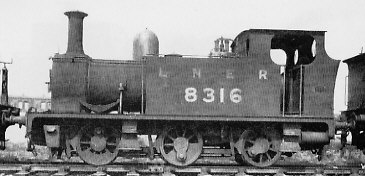The Mid-Suffolk J64 0-6-0T Locomotives

The Mid-Suffolk Light Railway (MSLR) ran for 19 miles from the Great Eastern Railway (GER) at Haughley to the village of Laxfield in central Suffolk. This was a part of a much more ambitious scheme to connect Westerfield Junction (near Ipswich) to Halesworth with a branch to Haughley via Kenton. The line was opened under a Light Railway Order to carry goods in 1904 and had already entered the hands of a receiver in 1907, before carrying its first passengers in 1908. The MSLR would remain in the hands of the receivers until 1st July 1924, when it was absorbed by the LNER.
The MSLR owned three locomotives. All three were 0-6-0Ts built by Hudswell, Clarke & Co., and were of typical Hudswell design as supplied to private owners and contractors. The LNER gave them the classification "J64". Nos. 1 & 3 were delivered in November 1904, whilst the slightly smaller No. 2 was delivered in April 1909. Upon entering LNER ownership, No. 3 was immediately withdrawn. Nos. 1 & 2 were renumbered as 8316 and 8317 respectively.
Heavy overhauls were carried out at the GER Works at Stratford, during both MSLR and LNER ownership. The last overhaul for No. 8316 was in September 1925, when the cylinders were bored out to 13.8in. No. 2 (No. 8317) received its last major overhaul in March 1925.
Due to the very light nature of the MSLR track, derailments were common. During MSLR ownership, all three engines carried their own jacks for re-railing, but these had been removed by the time of the 1925 overhauls.
The three locomotives were usually sufficient for the MSLR's day-to-day needs, although it did find itself short of motive power if one of the locomotives was being overhauled. To compensate, the GER regularly loaned a small 0-6-0T Class E22 (LNER J65) to the line. During LNER ownership, the J65s quickly took over the branch, and the J64s were moved to Ipswich (No. 8316) and Parkeston (No. 8317) to operate as shunters. Immediately before withdrawal in 1929, No. 8317 replaced a Y5 0-4-0T as the Stratford Carriage Works shunter.
No. 8316 was withdrawn in January 1928, and No. 8317 was withdrawn December 1929.
Technical Details
No. 3 was immediately withdrawn by the LNER, and did not receive an LNER engine diagram. It is believed to have been similar to No. 8316 but with 14in diameter cylinders.
| No. 8316 | No. 8317 | ||
| Cylinders (x2): | (inside) | 13.75x20in. | 13x20in. |
| Motion: | Stephenson | Stephenson | |
| Valves: | Slide | Slide | |
| Boiler: | Diameter (max): | 3ft 8in | 3ft 8in |
| Length: | 8ft 10in | 8ft 4in | |
| Boiler Pressure: | 140psi | 140psi | |
| Diagram No: | - | 44 | |
| Heating Surface: | Total: | 487.16 sq.ft. | 463.36 sq.ft. |
| Firebox: | 52.41 sq.ft. | 52.41 sq.ft. | |
| Tubes: | 434.75 sq.ft. (104x 1.75in dia.) | 410.95 sq.ft. (104x 1.75in dia.) | |
| Grate Area: | 8.86 sq.ft. | 8.86 sq.ft. | |
| Wheels: | 3ft 4.5in | 3ft 4.5in | |
| Total Wheelbase: | 12ft | 11ft 6in | |
| Tractive Effort: | (at 85%) | 11,110 lb | 9,931 lb |
| Length: | 25ft 6in | 25ft | |
| Weight: | 29t 3cwt | 28t | |
| Max. Axle Load: | 11t 2cwt | 12t 7cwt | |
| Water Capacity: | 570 gallons | 600 gallons | |
| Coal Capacity: | 1t 6cwt | 1t 3cwt |
Names
No. 1 was named Haughley when delivered. Nos. 2 & 3 were probably named Kenton and Laxfield although confirmation for this is hard to find. The names were removed shortly after delivery.
Preservation
The last J64 was withdrawn in 1929, and none survive into preservation.
Models
I am not aware of any models of the J64s in any scale.